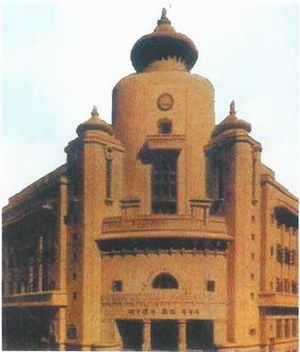Bharatiya Vidya Bhavan
From Hindupedia, the Hindu Encyclopedia
By Swami Harshananda
Foundation of Bharatiya Vidya Bhavan[edit]
The Bharatiya Vidya Bhavan was founded in A. D. 1938 (at Bombay, now Mumbai) by K. M. Munshi (A.D. 1887-1971), one of the prominent leaders of the freedom movement in India. It is dedicated to spread the educational and cultural values of the religion.
Goal of Bharatiya Vidya Bhavan[edit]
It is true to its goal of revitalizing dharma or the Moral Law. It is in its threefold form as belows :
- Satyam - Truth
- Śivam - Auspiciousness
- Sundaram - Beauty
Working of Bharatiya Vidya Bhavan[edit]
- The organisation strives to carry forward country’s ageless message of Śraddhā (Faith), Saiyama (Self-discipline) and Samarpaṇa (Dedication).
- The activities of this institution are spread over various fields such as education, literature, morality, art and culture as well as spiritual values also. It has scrupulously kept itself away from the political field.
- Over the last seven decades it has established 121 centers all over India and abroad, with 315 constituent institutions.
- So far it has published 1700 titles of books with sales crossing 26 millions.
- Its most valuable publication has been the book, The History and Culture of the Indian People, in eleven volumes.
- Through its various institutions it is imparting education in subjects like Sanskrit, Indology, Indian Culture including music, dance and painting, as also yoga, ancient scriptures and languages.
- It is also promoting national integration, communal harmony, purity in public life and rural upliftment through suitable programs.
References[edit]
- The Concise Encyclopedia of Hinduism, Swami Harshananda, Ram Krishna Math, Bangalore

